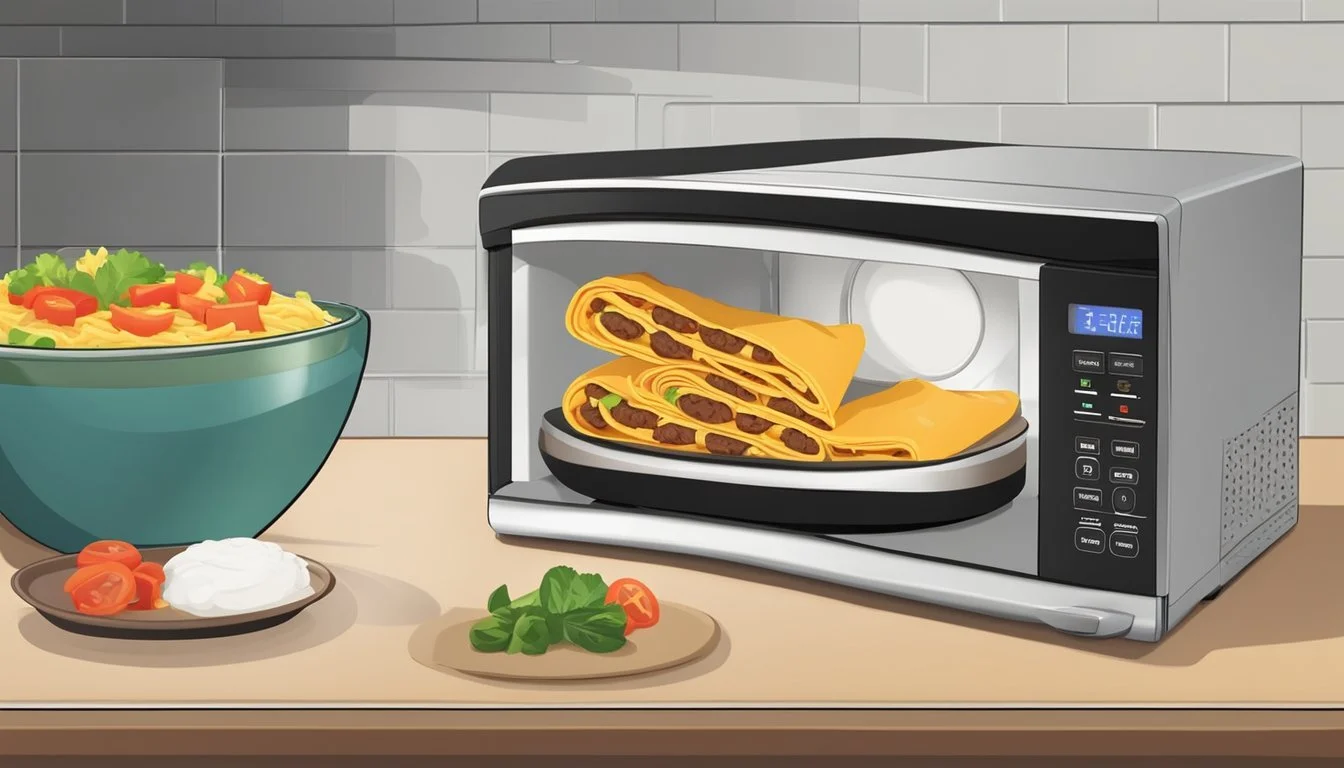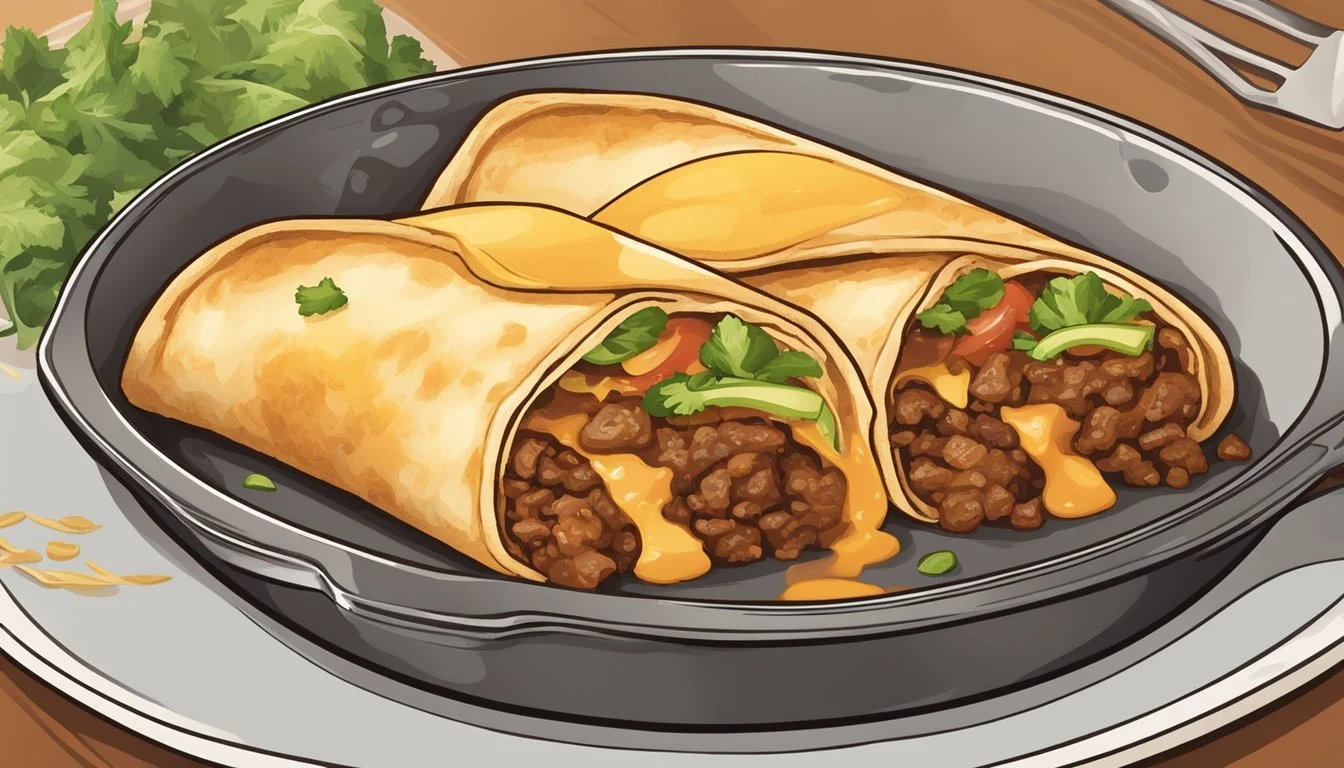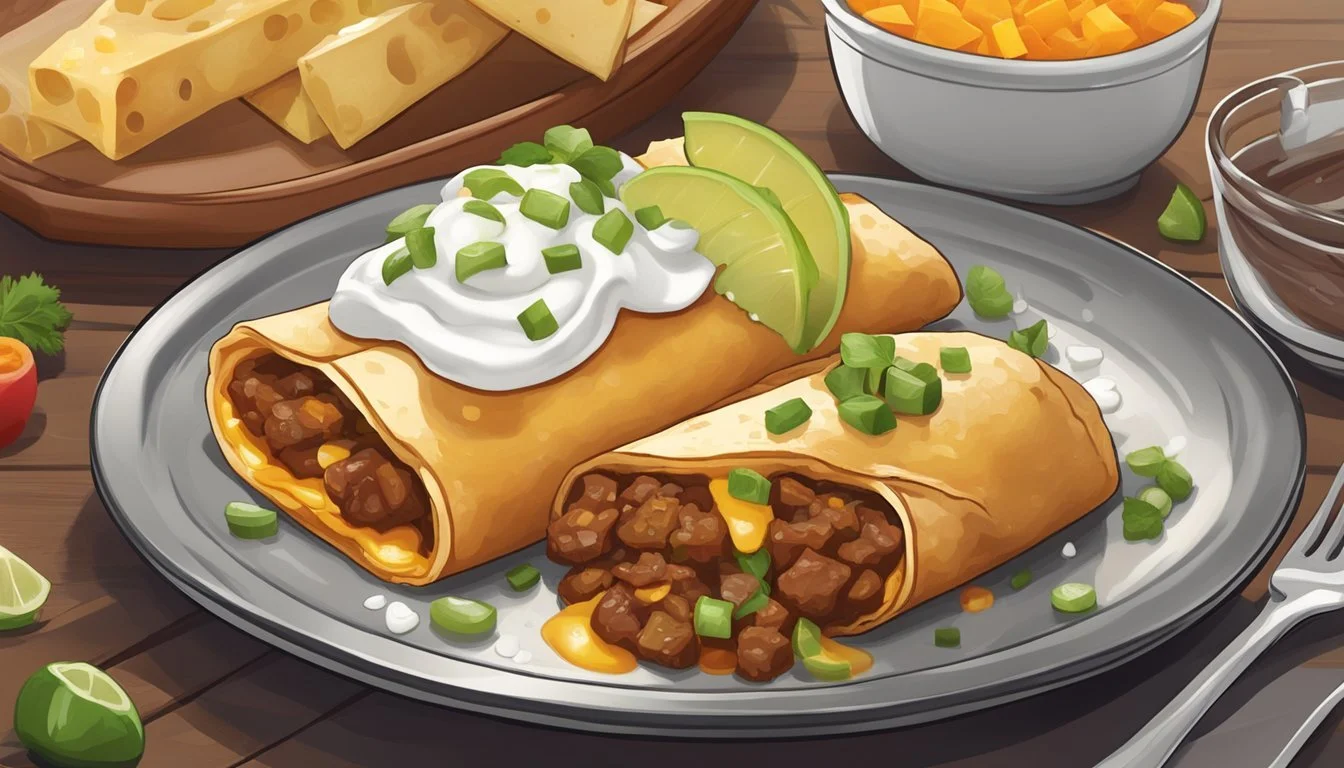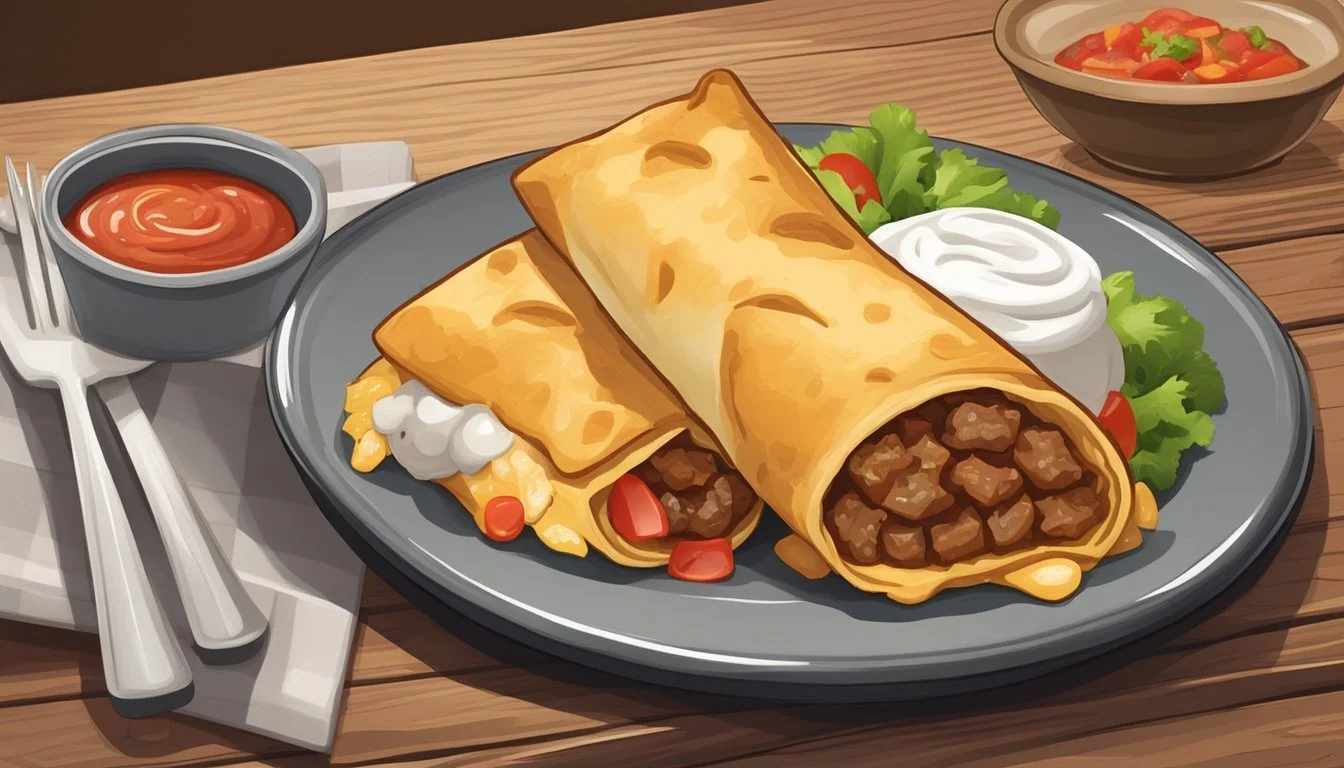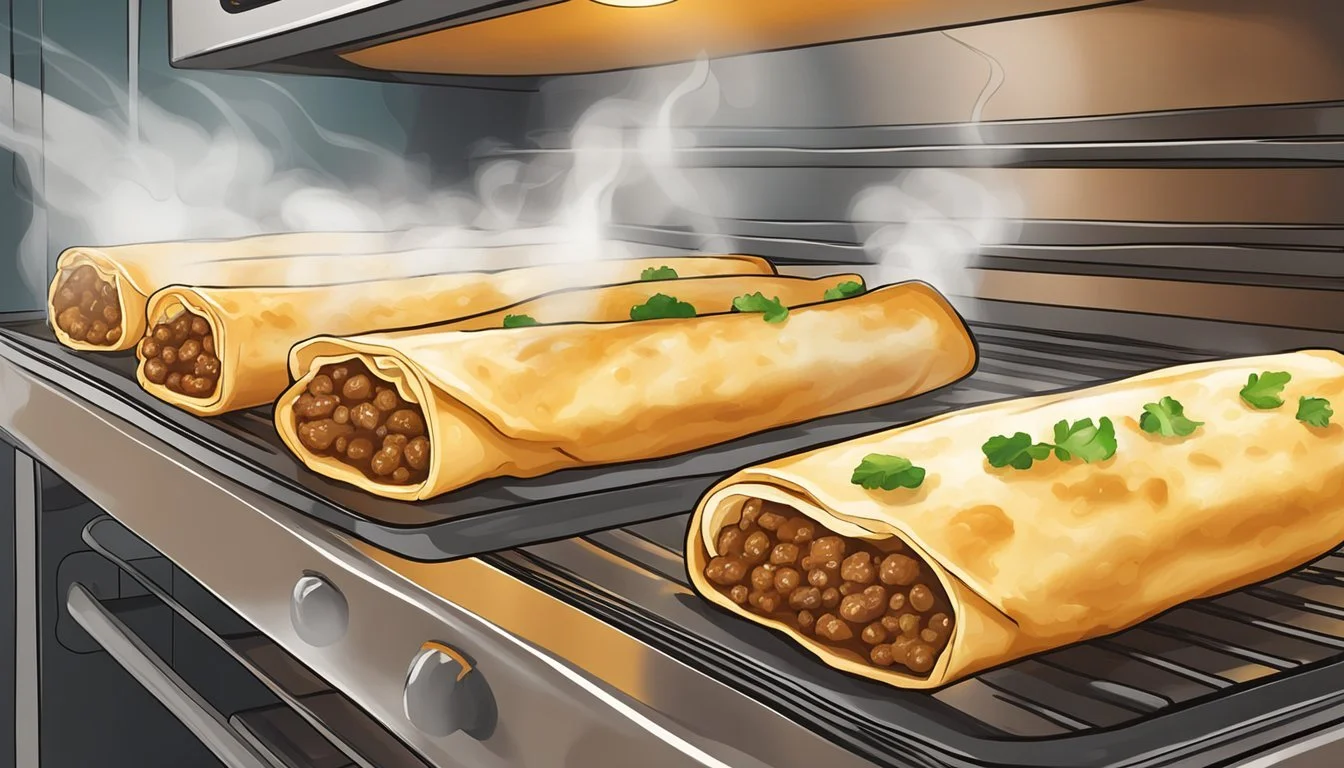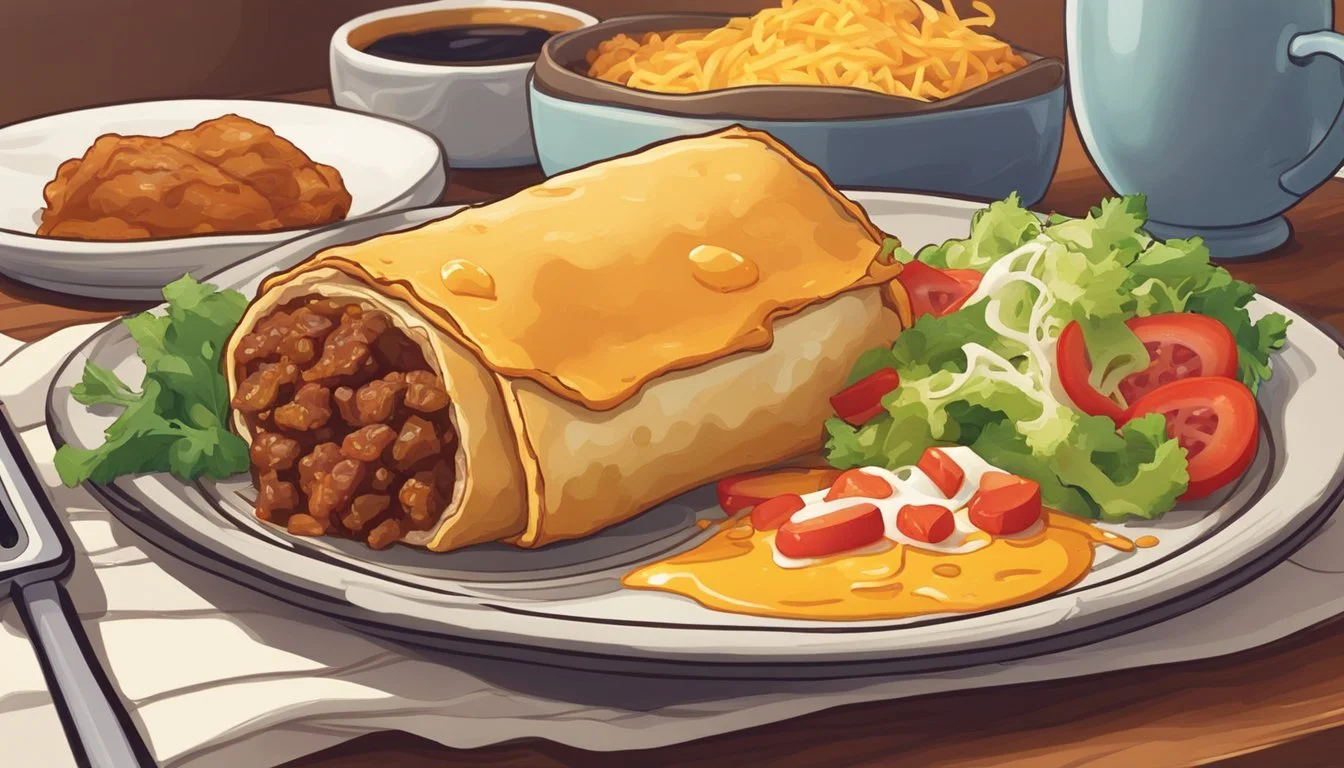How to Reheat Beef and Cheese Chimichangas
Expert Tips for Perfect Results
Beef and cheese chimichangas are a delightful fusion of Mexican and Tex-Mex cuisine, offering a mouthwatering combination of seasoned meat, melted cheese, and a crispy tortilla shell. Whether you've made a fresh batch or stored leftovers, knowing how to reheat them correctly is essential to maintaining their delicious flavor and texture.
The best ways to reheat beef and cheese chimichangas involve using an air fryer or oven to ensure they remain crispy on the outside while thoroughly heated inside. For those who prefer a softer exterior, using a microwave with a damp paper towel can be a convenient option.
With these methods, you'll be able to savor your chimichangas as if they were freshly prepared, bringing the vibrant tastes of this dish back to life.
Understanding Chimichangas
Chimichangas are a popular dish that can be enjoyed in multiple variations such as beef and cheese, chicken, or vegetarian. Originating from Mexican cuisine, they have become a staple in Tex-Mex cooking.
What Is a Chimichanga
A chimichanga is essentially a deep-fried burrito. It typically consists of a flour tortilla filled with a variety of ingredients such as beef, cheese, chicken, beans, vegetables, or seafood. Once filled, the tortilla is folded into a rectangular shape and deep-fried until crispy.
This cooking method results in a crunchy exterior that contrasts beautifully with the soft and savory interior. Beef and cheese chimichangas remain a favorite, but other variations like breakfast chimichangas and seafood chimichangas offer delicious alternatives.
The History of Chimichangas
The exact origins of the chimichanga are debated. Some sources claim it originated in Mexico, while others argue it was invented in the United States. According to one popular story, the dish was accidentally created in a Tucson, Arizona restaurant when a burrito was mistakenly dropped into a deep fryer.
Regardless of its true origins, the chimichanga has been embraced as a beloved Tex-Mex dish. It has even inspired various regional twists, including vegetarian and chicken chimichangas. Whether served as a main course or a snack, the chimichanga remains a testament to the fusion of Mexican and American culinary traditions.
Ingredients & Preparation
Preparation involves selecting the right ingredients and correctly assembling the chimichangas for optimal taste and texture. Key ingredients include ground beef, shredded cheese, seasonings, and flour tortillas.
Classic Beef and Cheese Filling
The foundation of a delicious chimichanga is a well-seasoned beef and cheese filling. Start by browning 1 pound of ground beef in a skillet over medium heat. Drain excess grease, then add 1 finely chopped onion and 2 minced garlic cloves. Cook until the onion softens.
Add 1 teaspoon of ground cumin, 1 teaspoon of oregano, salt, and black pepper to taste. Stir in 1 tablespoon of chili powder and optionally, add green chilies for extra flavor. Cook until spices are fragrant. Remove from heat and mix in 1 cup of shredded cheese until it melts into the beef mixture. Let the filling cool slightly before use.
Wrapping Techniques
Use flour tortillas for the best texture. Place a tortilla on a flat surface and add a generous spoonful of the beef filling in the center, making sure to leave space at the edges for folding. Optional spread of refried beans can be added first for an extra layer of flavor.
To wrap, fold in the sides, then roll the bottom edge over the filling and continue rolling tightly. Secure with toothpicks if needed. For frying, heat oil in a skillet, and cook each side until golden brown. For baking, preheat your oven to 375°F, place the chimichangas on a baking sheet, and bake for 20-25 minutes until crispy.
Follow these steps for perfect chimichangas every time.
Cooking Methods
To achieve delicious beef and cheese chimichangas, there are two primary methods to consider: deep-frying and baking. Each method offers a distinct texture and flavor, catering to different preferences.
Deep-Frying Chimichangas
Deep-frying is ideal for those who enjoy a crispy, golden exterior. Begin by heating vegetable oil in a skillet over medium heat until it reaches approximately 350°F. Carefully place each chimichanga in the hot oil, ensuring they don't overlap. Fry them for about 3-5 minutes per side, or until they are thoroughly crispy and golden brown.
Utilizing a slotted spoon, remove the chimichangas from the oil and let them drain on a plate lined with paper towels to absorb excess oil. This method ensures a crisp texture while keeping the beef and cheese filling warm and melty.
Baking Option
For a healthier alternative, baking is a suitable method. Preheat the oven to 350°F. Line a baking sheet with parchment paper and place the chimichangas on it, making sure there is enough space between each one for even heat distribution. For added moisture retention, loosely cover the chimichangas with aluminum foil.
Bake for 20-25 minutes until the chimichangas are heated through and the edges are slightly crispy. If desired, the foil can be removed in the last 5 minutes to enhance crispiness. Baking maintains the savory flavors without the added oil, providing a lighter, yet still satisfying option.
Reheating Techniques
Reheating beef and cheese chimichangas can be done using several methods to maintain their crispy exterior and flavorful fillings. Below are the techniques using various kitchen appliances to ensure the best outcomes.
Using an Oven
Preheat the oven to 350°F (175°C). Place the chimichangas on a baking sheet lined with aluminum foil or parchment paper. Make sure they are evenly spaced apart.
For moist chimichangas, cover loosely with aluminum foil to trap moisture. Bake for 15-20 minutes, flipping once halfway through the baking time. Check for doneness by ensuring the chimichangas are heated through and crispy. Removal from the oven can be done when the internal temperature reaches 165°F, indicating they are ready to eat.
Microwave Method
For a quicker option, the microwave works well, though the texture might be slightly different. Place the chimichangas on a microwave-safe plate. To retain moisture, cover them with a damp paper towel.
Microwave on high for 1-2 minutes until heated through. Check to ensure even heating, flipping halfway if necessary. Note that the microwave may not keep the chimichangas as crispy, but it is a convenient method for faster results.
Air Fryer Approach
Preheat the air fryer to 350°F. Arrange the chimichangas in the basket without overlapping to ensure even reheating. This method excels at maintaining a crispy texture.
Cook for 5-10 minutes, flipping once or twice during the process. Check periodically to avoid overcooking. Once the chimichangas are hot and crispy, they are ready to be served. Air fryers are effective for keeping the outer layer crunchy.
Skillet Reheating
For a stovetop option, the skillet provides a crisp texture. Heat a skillet over medium heat and add a small amount of oil to prevent sticking.
Place the chimichangas in the skillet, cooking each side for 3-4 minutes until thoroughly heated and golden brown. Frequently flip to avoid burning and ensure consistent heating. This method results in a fresh, fried texture similar to newly made chimichangas.
Serving Suggestions
Complement your reheated beef and cheese chimichangas with a variety of delicious toppings and side dishes to enhance their flavors. The right additions can turn your meal into a satisfying and complete dining experience.
Topping Ideas
Elevate the taste of your chimichangas with sour cream, guacamole, and salsa. These toppings add a creamy, zesty contrast to the crispy exterior of the chimichangas.
Another excellent option is shredded lettuce and chopped tomatoes, which provide a refreshing crunch and burst of flavor.
For some added heat, sprinkle on some diced jalapeños or a dollop of spicy hot sauce.
Make sure to have lime wedges on the side, as a squeeze of lime can add a tangy zest to each bite.
Side Dishes
Pair your chimichangas with complementary sides like Mexican rice and refried beans to create a more balanced meal.
For a lighter side, consider a simple salad with lettuce, tomatoes, and a light vinaigrette.
Corn on the cob or grilled vegetables can add a smoky flavor that pairs well with the rich, savory chimichangas.
Serve with tortilla chips and a variety of dips such as queso and pico de gallo to complete the meal. This way, you ensure there is something for everyone to enjoy.
Storage & Make-Ahead Tips
Proper storage methods ensure that beef and cheese chimichangas maintain their flavor and texture. Following these tips will help keep your leftovers fresh and ready for future enjoyment.
Storing for Freshness
To keep chimichangas fresh, store them in an airtight container within two hours of cooking. If planning to eat them within a few days, refrigerate at 40°F (4°C) or below.
Freezing & Thawing
For longer storage, freezing is an excellent option. Wrap each chimichanga tightly in aluminum foil or plastic wrap, then place in a zip-top bag to prevent freezer burn.
To thaw, transfer frozen chimichangas to the refrigerator for several hours or overnight. This gradual thawing method helps retain moisture and texture.
Variations and Substitutions
When reheating beef and cheese chimichangas, there are various ways to adjust the recipe to accommodate different dietary needs and preferences. You can also experiment with different fillings to create unique flavor profiles.
Dietary Adjustments
For those looking to reduce fat content, baking instead of frying can be an excellent option. Baking the chimichangas at 400°F for 10-15 minutes, lightly sprayed with cooking oil, can result in a crisp exterior without the added calories from frying.
In terms of cheese, opting for lower-fat cheeses or non-dairy alternatives can cater to dietary restrictions. Non-dairy cheeses, like shredded almond or coconut-based varieties, melt well and can provide a similar texture to traditional cheese.
Vegetarian chimichangas can be made by substituting beef with protein-rich alternatives like black beans, shredded chicken substitute, or even tofu. These options provide a satisfying filling without the need for meat.
Alternative Fillings
For a spicier kick, consider adding jalapeños or enhancing the filling with extra taco seasoning. These ingredients can elevate the traditional beef and cheese chimichanga, adding layers of flavor.
Instead of ground beef, shredded chicken can be a delightful substitution. Slow-cooked chicken with taco seasoning can be just as flavorful and tender as beef, offering a different texture and taste experience.
For a vegetarian twist, fillings like black beans, corn, and bell peppers can be seasoned and combined to create a hearty and nutritious alternative. Adding cheese or a cheese substitute to these vegetables can create a satisfying mixture that remains true to the essence of a chimichanga.
Experimenting with various fillings allows for endless culinary possibilities while maintaining the core elements that make chimichangas a beloved dish.
Safety Measures & Best Practices
When reheating beef and cheese chimichangas, it is important to handle hot ingredients carefully and avoid cross-contamination to ensure safety and enhance the culinary experience. These key practices will help maintain the right temperature and cleanliness during preparation.
Handling Hot Ingredients
When dealing with hot chimichangas, use proper equipment such as oven mitts or silicone gloves to prevent burns. Check the internal temperature with a food thermometer; it should reach at least 165°F (74°C) to ensure the filling is thoroughly reheated.
When using an oven or air fryer, always preheat the appliance to the recommended temperature, typically around 350°F (175°C). This ensures even cooking. Allow the chimichanga to rest for a few minutes before serving; this helps distribute heat evenly and enhances flavor.
Avoiding Cross-Contamination
To avoid cross-contamination, ensure that all utensils and surfaces used for reheating are clean and sanitized. Separate raw and cooked foods by using different cutting boards and utensils. Wash hands thoroughly before handling the chimichangas, especially if switching between raw and cooked foods.
Store leftovers appropriately in airtight containers to prevent exposure to bacteria. When reheating, if using a microwave, cover the chimichanga with a microwave-safe lid or plastic wrap to prevent splatters and maintain moisture. Flip halfway through cooking to ensure even heating. By following these steps, you can enjoy safe and delicious reheated chimichangas.
Enhancing Your Chimichanga Experience
Elevating your chimichanga enjoyment can be achieved by pairing them with the right drinks and setting up a fun chimichanga bar.
Pairing with Drinks
Drink pairings can enhance the flavors of beef and cheese chimichangas. For a refreshing option, margaritas work well, especially ones with a hint of lime or a touch of spicy jalapeño. If you prefer non-alcoholic options, iced tea with a squeeze of lemon provides a balancing mild acidity.
For beer lovers, a Mexican lager offers a light, crisp taste that complements the rich flavors of chimichangas. Sangria with its fruity and slightly tangy notes also pairs wonderfully, as the sweetness balances the spices in the chimichanga.
Having a mix of drink options allows everyone to find something that suits their palate while enjoying a meal that is both delightful and satisfying.
Creating a Chimichanga Bar
A chimichanga bar adds a fun and interactive element to your dining experience, allowing guests to personalize their meals. Start by laying out a variety of toppings and sauces such as guacamole, sour cream, pico de gallo, and different types of salsas.
Including a selection of hot sauces and spices provides additional flavor options. Add bowls of shredded lettuce, diced tomatoes, and onions for texture contrast.
Set up a station with preheated beef and cheese chimichangas so guests can grab one and customize to their liking. This quick and easy setup encourages creativity and ensures that everyone gets a chimichanga that's bursting with their preferred flavors and textures.
A collection of toppings and sauces not only adds variety but also makes the whole meal more approachable and fun for all.

